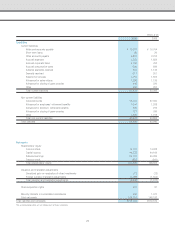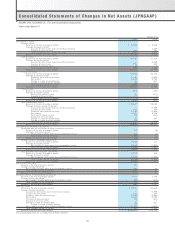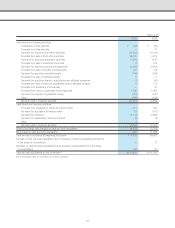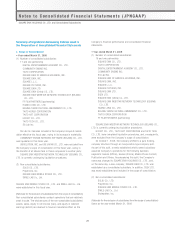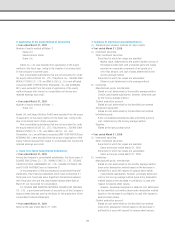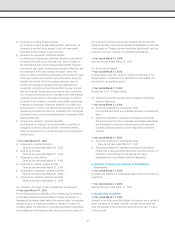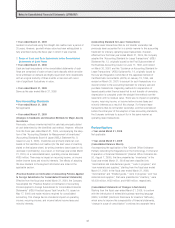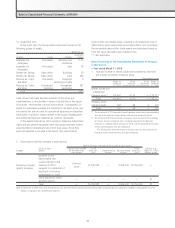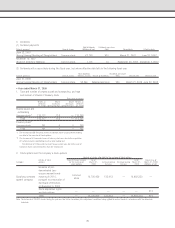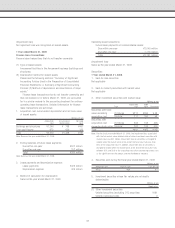Square Enix 2009 Annual Report Download - page 32
Download and view the complete annual report
Please find page 32 of the 2009 Square Enix annual report below. You can navigate through the pages in the report by either clicking on the pages listed below, or by using the keyword search tool below to find specific information within the annual report.
Raw materials, unfinished goods:
Domestic consolidated subsidiaries state raw materials and
unfinished goods at cost determined by the moving-average
method (book-entry devaluation method based on the decrease
in profitability is used with respect to balance sheet values).
Supplies:
Stated at the last purchase price
(2) Method of depreciation and amortization of major assets:
• Year ended March 31, 2008
A) Property and equipment
Property and equipment of the Company and its domestic
consolidated subsidiaries are depreciated using the declining-
balance method. However, the straight-line method is applied
to buildings (excluding building fixtures) acquired on or after
April 1, 1998. The estimated useful lives of major assets are
as follows:
Buildings and structures 3–65 years
Tools and fixtures 3–15 years
Amusement equipment 3–8 years
Change in method of depreciation
Pursuant to the revision of the Corporation Tax Law, effective this
fiscal year, for tangible fixed assets acquired on or after April 1,
2007, the Company and its domestic consolidated subsidiaries
have changed their method of accounting for depreciation to that
provided under the revised Corporation Tax Law.
The impact of this change was an ¥828 million decrease in
operating income, and an ¥829 million decrease in recurring
income and income before income taxes and minority interests
from the corresponding amounts which would have been
recorded under the previous method.
The impact of this change on segment information is presented
in the applicable section of these notes.
Additional information
Pursuant to the revision of the Corporation Tax Law, effective
this fiscal year, for assets acquired on or before March 31,
2007, the Company and its domestic consolidated subsidiaries
apply the method of accounting for depreciation provided in the
Corporation Tax Law prior to the revision and depreciate the
difference between 5% of an asset’s acquisition cost and its
memorandum value using the straight-line method over a period
of five years, from the fiscal year following the fiscal year in which
the net book value of the asset reaches 5% of its acquisition
cost. These differences are recorded in depreciation expense.
The impact of this change was a ¥149 million decrease in
operating income and recurring income, and a ¥146 million
decrease in income before income taxes and minority interests
from the corresponding amounts which would have been
recorded under the previous method.
The impact of this change on segment information is presented
in the applicable section of these notes.
B) Intangible assets
The Company and certain consolidated subsidiaries amortize
software used in-house using the straight-line method, based
on an internal estimate of its useful life (five years).
Trademarks are amortized using the straight-line method over
a period of 10 years.
• Year ended March 31, 2009
A) Property and equipment (excluding leased assets)
Property and equipment of the Company and its domestic
consolidated subsidiaries are depreciated using the declining-
balance method. However, for buildings (excluding building
fixtures) acquired on or after April 1, 1998, and overseas
consolidated subsidiaries, the straight-line method is applied.
The estimated useful lives of major assets are as follows:
Buildings and structures 3–65 years
Tools and fixtures 3–15 years
Amusement equipment 3 years
(auxiliary components : 5 years)
B) Intangible assets (excluding leased assets)
Same as the year ended March 31, 2008
C) Leased assets
Leased assets under finance lease transactions that do not
transfer ownership.
Depreciation for leased assets is computed under the
straight-line method over the lease term with no residual value.
Among finance lease transactions that do not transfer ownership,
those lease transactions that commenced on or before March
31, 2008, are accounted for in the same manner as operating
lease transactions.
(3) Accounting for allowances and reserves:
• Year ended March 31, 2008
A) Allowance for doubtful accounts
An allowance for doubtful accounts provides for possible losses
on defaults of accounts receivable. The allowance is made up of
two components: the estimated credit loss on doubtful receivables
based on an individual assessment of each account, and a
general reserve calculated based on historical default rates.
B) Reserve for bonuses
A reserve for bonuses is provided for payments to employees
of the Company and its consolidated subsidiaries at the amount
expected to be paid in respect of the calculation period ended
on the balance sheet date.
C) Allowance for sales returns
An allowance is provided for losses on the return of published
materials, at an amount calculated based on historical experience,
prior to this fiscal year. In addition, an allowance is provided for
losses on the return of game software and other items, at an
estimated amount of future losses assessed by game title.
Notes to Consolidated Financial Statements (JPNGAAP)
30





